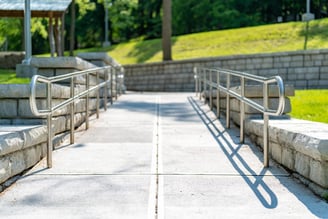CALL US TODAY! → (321) 202-7780
Building Accessible Spaces: The Importance of Durable Concrete Ramps
Accessibility done right. Discover what makes a concrete ramp safe, legal, and durable. Built for homes, schools, and businesses.
3/27/20255 min read


Understanding Accessibility and the Role of Ramps
Accessibility plays a vital role in ensuring that all individuals, regardless of their physical capabilities, can engage with their environment, whether at home, in businesses, or within public spaces. It not only promotes independence for those with mobility challenges but also fosters inclusivity, reflecting the community’s commitment to equal rights and opportunities. One of the key components of an accessible environment is the utilization of ramps, which facilitate movement and access where steps and barriers might otherwise impede individuals with disabilities or those using mobility aids.
The presence of ramps is essential in defining an accessible space. By providing smooth transitions between different levels, ramps serve as critical links that enhance the overall navigability of an environment. This is particularly evident in public areas like parks, libraries, and transit stations, where a well-designed ramp can make a substantial difference. A thoughtfully constructed ramp not only follows the guidelines of universal design but also complies with the Americans with Disabilities Act (ADA), which mandates that public spaces must be accessible to individuals with disabilities. This compliance is crucial, as it addresses the legal requirements for accessibility and serves as a framework to ensure that proper features are integrated into architecture and urban planning.
Moreover, the impact of effective ramp design extends beyond mere compliance with regulations; it significantly influences the sense of welcome and safety experienced by individuals with mobility challenges. By fostering an environment that is easily navigable, communities can ensure that everyone has the opportunity to participate fully, whether it be in social activities, employment, or daily errands. Accessibility through ramps not only meets essential legal standards but also embodies a collective commitment to dignity, respect, and equality in our society.
Key Features of ADA-Compliant Concrete Ramps
ADA-compliant concrete ramps are a critical component in ensuring accessibility for all individuals, particularly those with mobility challenges. Several key features define the effectiveness and safety of these ramps. One of the primary design considerations is the slope ratio, which must adhere to specific guidelines to mitigate the risk of accidents. According to the ADA standards, the recommended slope for wheelchairs is 1:12, meaning that for every inch of height, there should be at least 12 inches of ramp run. This ratio ensures that the ramp is not overly steep, facilitating safe navigation for users.
In addition to slope, edge protection is another vital feature of ADA-compliant ramps. Edge protection helps prevent individuals from inadvertently rolling off the side of the ramp, which can lead to falls and injuries. This can be achieved through the incorporation of curbs, barriers, or raised edges that are integrated into the ramp design. Adequate edge protection is especially important in outdoor settings where uneven surfaces may pose additional risks.
The texture of the ramp surface plays a significant role in both its safety and durability. Textured finishes are essential to provide improved traction, reducing the likelihood that users will slip, particularly in wet conditions. This tactile element allows individuals with varying degrees of mobility to confidently navigate the ramp. An optimal surface finish will also endure the wear and tear that concrete ramps typically face, ensuring longevity and maintaining the integrity of the design.
In conclusion, the effective design of ADA-compliant concrete ramps necessitates a careful balance of slope ratios, edge protection, and surface texture. Each of these elements contributes significantly to the safety, durability, and functionality of the ramps, ultimately fostering an inclusive environment for individuals with disabilities.
The Design Process: Creating Comfortable and Functional Ramps
The design process for constructing accessible concrete ramps is crucial in ensuring that these structures meet both the functional needs of users and maintain aesthetic value within their surroundings. A comprehensive design approach prioritizes user comfort by carefully considering several critical elements, such as the width of the ramp, turning options, and landings. These factors not only enhance usability but also ensure compliance with established accessibility standards.
First and foremost, the ramp's width should accommodate a variety of users, including those utilizing wheelchairs, walkers, or other mobility aids. A minimum width of 36 inches is typically recommended to allow for easy passage and comfort while navigating the ramp. In addition, the design should incorporate gradual turns rather than sharp angles to facilitate safe maneuvering. This is particularly essential for individuals who may require additional space to turn around or change direction during their ascent or descent.
Landings play a significant role in the overall comfort and functionality of the ramp. They should be positioned at the top and bottom of the ramp and at intervals along the slope, providing users with a resting space if needed. These areas can also be strategically integrated into the environment to serve multiple purposes, such as providing access to adjoining pathways or outdoor features.
Aesthetics are an often-overlooked aspect of ramp design. While functionality is paramount, it is equally important for the ramp to blend seamlessly with its surroundings. Using materials that complement nearby structures and landscaping can enhance the visual appeal of the ramp without compromising its practical uses. Furthermore, thoughtful design that considers natural light and landscaping can improve user experience and promote a welcoming environment.
In conclusion, designing durable concrete ramps requires a balance of comfort, functionality, and aesthetics. By meticulously addressing each aspect, designers can create accessible spaces that cater to all users, fostering inclusivity and ease of movement within the community.
Conclusion: Investing in Safe and Durable Access Solutions
In today's world, accessibility for all individuals is not merely a choice but a necessity. Investing in well-constructed concrete ramps is a critical step towards achieving inclusive design. These ramps are not just functional elements; they serve as lifelines for individuals with disabilities, the elderly, and those navigating mobility challenges. By providing essential access to buildings and public spaces, durable concrete ramps enhance the quality of life for many individuals and promote independence.
The importance of durable ramps extends beyond immediate use. A well-built concrete ramp plays a vital role in ensuring compliance with accessibility standards, such as the Americans with Disabilities Act (ADA). This compliance not only mitigates potential legal and financial risks but also demonstrates a commitment to social responsibility and inclusivity. Property owners and developers should view the incorporation of durable concrete ramps as an investment in both their facilities and the community they serve.
Moreover, investing in high-quality, long-lasting materials for ramps reduces maintenance costs over time. Unlike temporary or poorly constructed solutions, durable concrete ramps withstand the test of time, weather conditions, and continuous use. This longevity translates into fewer repairs and replacements, thereby conserving both financial and environmental resources. It ultimately leads to a more sustainable approach to building accessible spaces.
At Ramos Elite Construction Corp, our expertise in constructing compliant and durable concrete ramps can ensure that your access solutions meet both safety standards and user needs. We understand that investing in these essential structures is not just a regulatory obligation, but an opportunity to foster an inclusive environment for everyone. By prioritizing accessibility, you are creating spaces that empower and uplift all members of the community, ensuring that barriers are effectively removed.
FOLLOW US ON SOCIAL MEDIA
SUBSCRIBE TO OUR NEWSLETTER
CALL:
HOURS:
Mon-Sat
7:00am-5:00pm
COPYRIGHT © 2025 RAMOS ELITE CONSTRUCTION CORP


